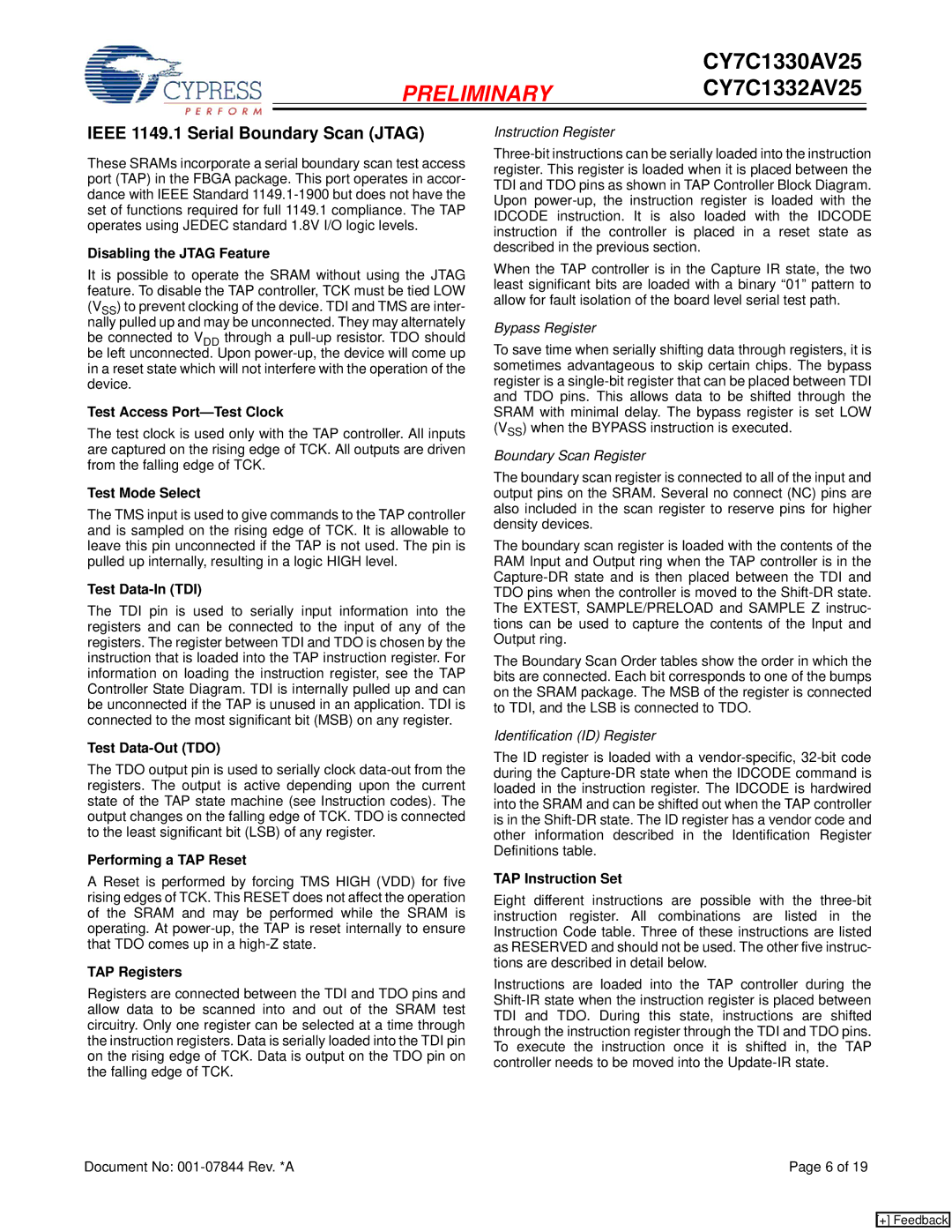
CY7C1330AV25
PRELIMINARYCY7C1332AV25
IEEE 1149.1 Serial Boundary Scan (JTAG)
These SRAMs incorporate a serial boundary scan test access port (TAP) in the FBGA package. This port operates in accor- dance with IEEE Standard
Disabling the JTAG Feature
It is possible to operate the SRAM without using the JTAG feature. To disable the TAP controller, TCK must be tied LOW (VSS) to prevent clocking of the device. TDI and TMS are inter- nally pulled up and may be unconnected. They may alternately be connected to VDD through a
Test Access Port—Test Clock
The test clock is used only with the TAP controller. All inputs are captured on the rising edge of TCK. All outputs are driven from the falling edge of TCK.
Test Mode Select
The TMS input is used to give commands to the TAP controller and is sampled on the rising edge of TCK. It is allowable to leave this pin unconnected if the TAP is not used. The pin is pulled up internally, resulting in a logic HIGH level.
Test Data-In (TDI)
The TDI pin is used to serially input information into the registers and can be connected to the input of any of the registers. The register between TDI and TDO is chosen by the instruction that is loaded into the TAP instruction register. For information on loading the instruction register, see the TAP Controller State Diagram. TDI is internally pulled up and can be unconnected if the TAP is unused in an application. TDI is connected to the most significant bit (MSB) on any register.
Test Data-Out (TDO)
The TDO output pin is used to serially clock
Performing a TAP Reset
A Reset is performed by forcing TMS HIGH (VDD) for five rising edges of TCK. This RESET does not affect the operation of the SRAM and may be performed while the SRAM is operating. At
TAP Registers
Registers are connected between the TDI and TDO pins and allow data to be scanned into and out of the SRAM test circuitry. Only one register can be selected at a time through the instruction registers. Data is serially loaded into the TDI pin on the rising edge of TCK. Data is output on the TDO pin on the falling edge of TCK.
Instruction Register
When the TAP controller is in the Capture IR state, the two least significant bits are loaded with a binary “01” pattern to allow for fault isolation of the board level serial test path.
Bypass Register
To save time when serially shifting data through registers, it is sometimes advantageous to skip certain chips. The bypass register is a
Boundary Scan Register
The boundary scan register is connected to all of the input and output pins on the SRAM. Several no connect (NC) pins are also included in the scan register to reserve pins for higher density devices.
The boundary scan register is loaded with the contents of the RAM Input and Output ring when the TAP controller is in the
The Boundary Scan Order tables show the order in which the bits are connected. Each bit corresponds to one of the bumps on the SRAM package. The MSB of the register is connected to TDI, and the LSB is connected to TDO.
Identification (ID) Register
The ID register is loaded with a
TAP Instruction Set
Eight different instructions are possible with the
Instructions are loaded into the TAP controller during the
Document No: | Page 6 of 19 |
[+] Feedback
